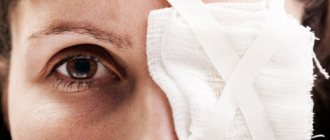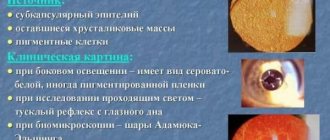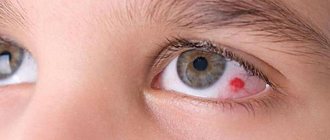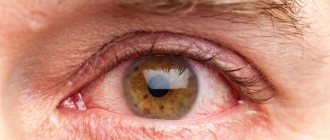Diagnosisforeign body of the eye"is well known to almost everyone. It is unlikely that there is at least one person who has never in his life experienced unpleasant sensations caused by a small insect, a speck of dust, an eyelash getting into the eye, that is, what is called a “foreign body”.
Foreign bodies can be superficial, i.e. located on the surface of the eye or intraocular - penetrating into the eye cavity and damaging its membranes.
Most superficial foreign bodies are removed from the eyes as a result of intense blinking and increased tear production. If this does not happen, then it is necessary to seek specialized medical help as soon as possible.
Metal particles getting into the eye are especially dangerous. Often they are so small that they do not cause significant discomfort and the victim does not seek medical help.
However, after a few days, he begins to notice that his vision has noticeably deteriorated. This is due to the oxidation of the metal. The most dangerous in this regard are copper particles, the oxides of which have a toxic effect on the cornea, lens and retina. Therefore, it is so important to promptly contact an ophthalmologist in case of a foreign body in the eyes.
Symptoms of a foreign body in the eyes
Signs of a foreign body in the eye can vary in intensity from slight, almost imperceptible discomfort to unbearable intense pain. It depends on the type of foreign body and its location. The main symptoms of a foreign body in the eye are:
- Burning;
- Scratching in the eye;
- Eye irritation;
- Painful sensations;
- lacrimation;
- Redness of the eye;
- Photophobia;
- Difficulty opening the affected eye;
- Deterioration of vision.
- Diagnosis of foreign bodies in the eye
If there is a suspicion of a foreign body in the eye, an ophthalmological examination is performed using a special slit lamp. If necessary, the doctor turns the upper eyelid inside out and checks for foreign particles underneath it.
To detect intraocular foreign bodies, an examination is carried out using an ophthalmoscope, an ultrasound of the eyeball is performed, as well as radiography in two projections.
Foreign body in the eye: removal methods
A foreign body in the eye is a foreign fragment that can be located in the orbit, on the cornea or eyeball. This is a serious and health-threatening problem that needs to be addressed. Therefore, in this article we will reveal the reasons for the penetration of foreign bodies and answer the question of how to get the speck out of the eye yourself and without consequences.
Causes
- There are many reasons why foreign particles get into the eyes, but it is worth noting the main ones:
- If the rules of personal hygiene are not observed, young children who do not always wash their hands after a walk are at risk. Sand, dust, and small particles of debris often get into the eyes.
- A workplace injury occurs when safety precautions are violated. Wood or metal particles may get into your eyes. Sometimes the particles fly off at such a high speed that when they enter the eye, they penetrate quite deeply, and this can cause serious damage to vision.
- It is the eyes that suffer from the wind. Strong gusts lift dust, small particles of debris, grains of sand, wood chips, etc. from the ground.
- Wearing contact lenses, with improper care and use, can cause foreign particles to enter the eye. Dirty, undisinfected hands, in this case, pose a danger.
- When wearing woolen items, small hairs can get caught on an eyelash and then get into the eye.
Symptoms of a foreign body
Symptoms vary depending on the size of the foreign particles. Some people experience unbearable pain, while others feel slight discomfort. It all depends on which place is affected and how much. Often, an existing foreign body in the eye reveals itself as discomfort, interference, burning, stinging, and redness of the mucous membrane. Symptoms such as increased lacrimation, photosensitivity, swelling of the eyelids, “foggy vision” and even bleeding due to vascular damage cannot be excluded. It also happens that a foreign particle gets inside the eye, and the person does not feel its presence, that is, there are no symptoms. If there is a suspicion that a foreign body has entered the eye, but there are no symptoms, then it is advisable to undergo an examination by an ophthalmologist in order to remove the foreign particle. If you leave everything to chance, serious vision problems may arise that are difficult to solve on your own.
Diagnostics
The foreign body must first be detected and determined which part of the eye it has affected. You can examine your eye yourself at home; it is enough to conduct the examination in a well-lit room with a mirror. A professional examination consists of a thorough examination of the mucous membrane. For this purpose, ophthalmologists use a slit lamp. If a specialist suspects that a foreign body is located inside the eye, then he turns out the upper eyelid and inspects the space under it. The patient's indications may lead the ophthalmologist to consider the need for an ultrasound or radiography. Symptoms and removal of foreign debris from the conjunctiva
A foreign body can be located on the surface of the conjunctiva, or it can penetrate much deeper, it all depends on the degree of penetration into the eye. The penetration of particles such as grains of sand, shavings, hairs or dust causes an unpleasant sensation or pain in a person. Harder materials such as stone, wood, coal or metal cause pain. The easiest way is to detect and remove from the eye an eyelash or a small particle located near the conjunctiva at home. The presence of a foreign particle of the conjunctiva can be diagnosed by a thorough external examination of the mucous membrane of the eyes using eyelid eversion. Thanks to reflex twitching of the eyes and profuse lacrimation, the foreign body moves freely through the conjunctival space; Often small particles get stuck in the groove, from where they can be easily removed. In order to painlessly remove a foreign body, specialists instill dicaine into the eyes. You can remove the foreign particle with medical tweezers or a needle. Cornea and foreign body removal
Often, chips or scale can be found on the surface of the cornea or a little deeper. The depth of penetration depends on the size of the particle and the speed at which the particle enters the eye. There are three types of occurrence of foreign particles: superficial, middle and deep. Deep bodies include metal pieces, stone or wood fragments. A foreign body dispersed in the cornea can damage the epithelium, which leads to the development of a disease called keratitis. According to the patient, discomfort, sharp pain, burning sensation, interference, photosensitivity and lacrimation are felt. Such symptoms require a thorough examination, the results of which can be verified using x-rays. Then you need to make an immediate decision on how to get the speck out of your eye. The ophthalmologist can remove the foreign piece after disinfecting the eyes with an anesthetic. A medical chisel or a special spear is used as a removal tool.
Removal of intraocular foreign bodies
Situations with intraocular foreign debris are less common than others. Most often, foreign materials enter the posterior ocular region. When examining a patient for the presence of a foreign fragment inside the eye, a specialist may detect a small hole in the cornea or pupil. The wound may be gaping. The patient experiences blurred vision, pain and burning. In this case, you should not make rash decisions about removing the particle yourself. Even with a strong desire, you cannot do this; here you need qualified help from a specialist. Foreign body of the orbit
Most often, the passage into the orbit for a foreign body is the conjunctiva or eyelid. This is a non-magnetic or magnetic particle, with different shapes and sizes, capable of penetrating into any part of the orbit. Thanks to double perforation of the eyeball, scale or a piece of metal can be detected. The consequences of damage from exposure to various metals can be as follows:
- Iron, cast iron, steel, aluminum metal particles, as well as shavings from stone or glass, cause minimal damage to the eye socket. A person has the feeling that an eyelash has gotten into the eye.
- Due to the penetration of a large copper fragment, an aseptic purulent process develops.
- Due to the introduction of wood particles, a septic purulent process of the eye orbit develops.
IMPORTANT! The diagnosis is made from the patient's words, a medical examination and an x-ray of the eyes. The verification examination is carried out using ultrasound. After diagnosis, surgical treatment of the damaged area is performed. If the particle is located near the wound, then it can be removed without additional manipulation. If a non-reactive state is established during the diagnostic process, then it is impossible to remove the fragment. In this case, the patient is prescribed antibiotics and sulfonamides. Important Tips
- Workers in carpentry and plumbing workshops, as well as agricultural facilities, must wear safety glasses while working.
- If there is a foreign particle, you should not rub your eyes - such manipulations will aggravate the problem.
- Minimize the amount of blinking (blinking irritates the injured eye).
- Do not try to get the fragment on your own.
- For help, it is better to contact a specialist, in this case an ophthalmologist, who needs to explain your actions in detail.
If you find a speck in your eye, you need to do the following:
- You can remove the speck using running water, which is used to wash the eye;
- you can close your eyes as hard as you can so that the protruding tears push away the speck;
- Using a clean napkin or handkerchief, remove the speck; in this case, you can make “Clock” movements with your eyes, that is, from side to side;
- If metal or wood shavings get into your eye or you find scale, you should immediately seek help from an ophthalmologist.
It should be remembered that the absence of symptoms, but suspicions of a foreign body entering the eye should prompt the idea of the necessary check. You should not let everything take its course.
Treatment of a foreign body in the eye
Removal of foreign bodies of the eyes, even those located superficially (in the conjunctiva, sclera or cornea), should only be performed by an ophthalmologist. Attempts to cope with this task on your own can lead to infection of the eyes or further injury to its structures. Superficially located foreign bodies are removed on an outpatient basis under local anesthesia. Most often, the procedure is performed using a special microscope - a slit lamp.
After it, anti-inflammatory and antibacterial eye ointments and drops are necessarily prescribed to prevent the development of a pronounced inflammatory reaction.
Removal of intraocular foreign bodies is carried out in the operating room using quite complex equipment, a microscope and various surgical instruments. Since penetrating wounds of the eyeball threaten the loss of visual function, and even the eye itself, the operation is performed immediately, i.e. for emergency reasons.
Diagnostics and first aid
A specialist can see a foreign body in the cornea during a standard examination of the patient. But in order to determine the depth of penetration and the degree of damage to the organ, special equipment is needed - a biomicroscope.
In cases where multiple penetration of foreign elements into the cornea is established, the patient is sent for radiography and gonioscopy. These studies make it possible to obtain a complete picture of the injury and exclude the presence of foreign bodies in the anterior chamber.
Before removing a foreign object, a local anesthetic is injected into the conjunctival sac. In ophthalmology, Dicaine is most often used. If the body has not penetrated deep into the cornea, but is located on its surface, it can be removed with a cotton swab. Objects that are located in the upper layers of the cornea are removed with a special chisel or spear.
If we are talking about the ingress of metal particles, then a kind of rust shell quickly forms around them - this, too, will certainly be removed by a specialist.
When the deep layers of the cornea are injured, a decision may be made not to remove foreign objects. Substances such as gunpowder, sand or stone do not cause allergic reactions and do not provoke an inflammatory process. Therefore, it is much more advisable to wait until they rise up of their own accord, then they can be removed without the risk of perforating the cornea or pushing a fragment into the anterior chamber.
If there is a pronounced inflammatory process accompanied by the formation of pus, it is recommended to analyze the removed foreign body in order to establish the reasons for the strong reaction of the eye tissue. For example, if it is determined that there were certain pathogenic microorganisms on the surface of the foreign body, the specialist will be able to select the correct therapy using drugs to which they are sensitive.
Best materials of the month
- Why you can't go on a diet on your own
- 21 tips on how to avoid buying stale food
- How to keep vegetables and fruits fresh: simple tricks
- How to curb your sweet cravings: 7 unexpected products
- Scientists say youth can be extended
What to do if there is a foreign body in the eye
If a foreign body gets into the eye, you should adhere to the following recommendations:
- Do not rub and generally touch the affected eye as little as possible. If you wear contact lenses, do not remove them. Any touch to the eye can change the original position of the foreign body and push it deep into the tissues of the eye.
- Try to keep the affected eye closed. The harder and more often you blink, the more irritated your eye will be.
- You should not attempt to remove a foreign body yourself or trust this procedure to random persons nearby. This is quite dangerous and fraught with serious consequences.
- Contact a medical facility as soon as possible for specialized ophthalmological care.
- Be sure to tell your doctor what substances or materials you were working with at the time of your injury.
Team of doctors Ochkov.Net
Principles of treatment
The main goal of treatment is to restore the integrity of the eye and remove the foreign body. The timing of removal may be determined by several factors, including the nature and location of the foreign body, the availability of necessary equipment, and qualified medical personnel.
The greatest danger to the eye comes from organic foreign bodies (plant parts), which quickly rot, which causes a powerful inflammatory process. They require particularly quick removal. However, in any other cases it is also necessary to remove the foreign body from the eye as quickly as possible.
Prevention of infectious complications must be carried out, which is done by intramuscular, intravenous or local (near or inside the eye) administration of antibiotics and anti-inflammatory drugs. If necessary, a tetanus vaccination is given.
The development of siderosis and chalcosis requires, after removal of the foreign body, a course of detoxification therapy, with maximum removal of toxic products from the eye.
How to protect your eyes from debris?
It is very difficult to protect your eyes from debris that gets into them. You never know when the wind will blow and raise dust and sand into the air. Also, a midge may suddenly fly in. But sometimes the eyes are more susceptible to injury, and then we can reduce the risk of debris. For example, when working with a saw, trimmer, grinder and other devices, as well as sharp materials (glass wool, mineral wool), you must use safety glasses.
Every person encounters a foreign body getting into the eye at least once in their entire life. Usually you can remove the debris yourself. But sometimes you need the help of a loved one, or even a doctor. To preserve your vision, do not leave debris in your eyes, and if you cannot remove it with your own hands or with the help of another person, or after removing it there remains a strong burning sensation, see a doctor immediately.
First aid
It is allowed to remove particles without the help of a doctor only if they enter non-penetrating bodies that are located in the conjunctival cavity. Take a pipette, clean water or saline solution. By washing the conjunctiva, the particle is removed. This procedure should be carried out in a lying position with sufficient lighting. It is important that when removing a foreign body from the eye, the victim behaves calmly and does not move. Before carrying out such a manipulation, you should wash your hands.
It is also recommended to drop a few drops of an anesthetic into the eye, if possible, for example, it could be Dicaine. In this way, pain or discomfort can be relieved, and this will also provide an opportunity to have a good look at the eye and take clear actions. After the drops are instilled, you need to wait a few minutes and only then carry out the extraction procedure.
To remove the particle from the eye, warm saline or water is instilled from a pipette under the eyelid. You should not use anything other than a pipette. If you take a bulb or syringe, the stream may be too strong.
The solution is instilled under the lower eyelid, gently pulling it upward. And only after making sure that there is nothing there, do they move on to the upper eyelid. The cavity under the upper eyelid is deeper and will require more careful inspection, testing and cleaning.
When the procedure is completed, you should again drip an antiseptic into the eye. You can use, for example, a solution of sodium sulfacyl; 4-7 drops will be enough to prevent conjunctivitis. If there is a suspicion that the particles have penetrated deeper, or a day has passed since the penetration of the foreign body, and there are signs of inflammation, or the damage to the eye is more serious, then you need to call an ambulance or seek help from a specialist. The victim is taken to an ophthalmologist, covering the previously damaged eye with a sterile napkin. In this way, it will be possible to protect the eye from repeated contamination, including microbial contamination.
Related:
- Red eye syndrome
- Eye injury, hyphema
- Foreign body/corneal erosion
- Bags under and above the eyes
- Sight and clarity of eyes
Next:
- Cardiac ischemia
- Late caries in adults
- Early caries in children
Signs of foreign body entry
Symptoms caused by foreign objects entering the eye can vary widely:
- mild discomfort or intense pain;
- redness of the eye;
- burning sensation;
- increased lacrimation;
- photophobia;
- reflex closing of the eyelids, difficulty when trying to open the affected eye;
- blurred vision.
The severity of the clinical picture depends on the type of foreign body, its size and location.









